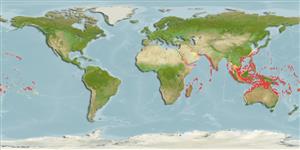>
Acanthuriformes (Surgeonfishes) >
Acanthuridae (Surgeonfishes, tangs, unicornfishes) > Acanthurinae
Etymology: Zebrasoma: Derived from Zebra = African horse + Greek, soma = body; referring to the stripes (Ref. 45335).
More on author: Cuvier.
Environment: milieu / climate zone / depth range / distribution range
Ekologi
laut berasosiasi dengan karang; kisaran kedalaman 0 - 60 m (Ref. 1602), usually 1 - 60 m (Ref. 27115). Tropical; 25°C - 28°C (Ref. 27115); 31°N - 34°S, 32°E - 124°W
Indo-Pacific: East Africa, including the Mascarene Islands (Ref. 37792) to the Tuamoto Islands, north to southern Japan, south to Lord Howe and Rapa islands.
Size / Weight / umur
Maturity: Lm ? range ? - ? cm
Max length : 40.0 cm SL jantan/; (Ref. 48637)
Duri punggung (Keseluruhan (total)): 4 - 5; duri punggung lunak (Keseluruhan (total)): 23-25; Duri dubur 3; Sirip dubur lunak: 19 - 21. Dark brown (body in life with fine pale blue-green longitudinal lines following scale rows, becoming dots anteriorly on body and on head) (Ref 9808). Small juveniles have yellowish bars and more prominent yellow specks than adults.
Occurs in coral-rich areas of lagoon and seaward reefs. Graze on algae, usually in groups of 20 individuals (Ref. 5503, 48637). Adults usually in small groups and sometimes schooling. Juveniles solitary and usually among corals (Ref. 48637). Its numerous, small pharyngeal teeth may have evolved in response to a shift in diet from macroalgae to filamentous algae (Ref. 33204). Form resident spawning aggregations (Ref. 27825). Monogamous (Ref. 52884). Group and pair spawning have been observed. The flesh is never poisonous (Ref. 4795). Minimum depth reported taken from Ref. 128797.
Life cycle and mating behavior
Kematangan | Reproduksi, perkembang biakan | Pemijahan | telur-telur | Fecundity | Larva
Form resident spawning aggregations (Ref. 27825). Monogamous mating is observed as both facultative and social (Ref. 52884).
Myers, R.F., 1991. Micronesian reef fishes. Second Ed. Coral Graphics, Barrigada, Guam. 298 p. (Ref. 1602)
Status IUCN Red List (Ref. 130435)
ancaman kepada manusia
Harmless
penggunaan manusia
Akuarium: Komersial
informasi lanjut
AcuanBudidaya airprofil budidaya airStrainGenetikaElectrophoresesDiturunkanPenyakit-penyakitPengolahanNutrientsMass conversion
Alat, peralatan
laporan khas
muat turun XML
Sumber internet
Estimates based on models
Preferred temperature (Ref.
123201): 24.6 - 28.9, mean 27.6 °C (based on 1646 cells).
Phylogenetic diversity index (Ref.
82804): PD
50 = 0.5078 [Uniqueness, from 0.5 = low to 2.0 = high].
Bayesian length-weight: a=0.02512 (0.02073 - 0.03043), b=2.98 (2.93 - 3.03), in cm total length, based on LWR estimates for this species (Ref.
93245).
Trophic level (Ref.
69278): 2.0 ±0.00 se; based on food items.
Daya lenting (Ref.
120179): sedang, Waktu penggandaan populasi minimum 1.4 - 4.4 tahun (K=0.425; Tmax=33).
Fishing Vulnerability (Ref.
59153): Moderate vulnerability (39 of 100).
Nutrients (Ref.
124155): Calcium = 25 [11, 80] mg/100g; Iron = 0.636 [0.219, 1.541] mg/100g; Protein = 17.8 [16.4, 19.2] %; Omega3 = 0.126 [0.058, 0.270] g/100g; Selenium = 14.1 [4.5, 75.6] μg/100g; VitaminA = 57.3 [10.9, 272.4] μg/100g; Zinc = 2.04 [0.90, 3.68] mg/100g (wet weight);
